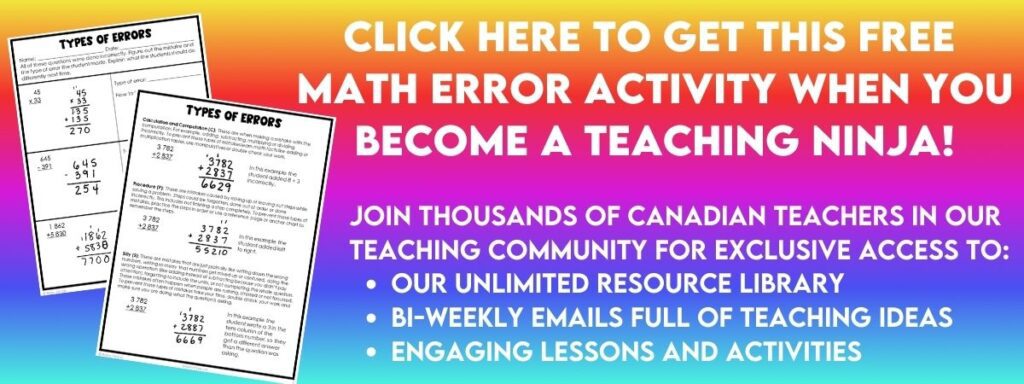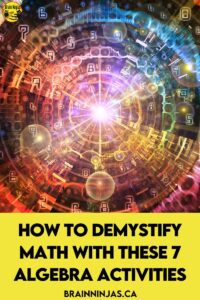
When we hear that we have to do algebra activities, the fear is real. Algebra is this haunting reminder of high school. When I was becoming a teacher, I didn’t want my negative experiences with math to influence how I taught it or, more importantly, how my students learned it.
In university, I was put in a “special” math class designed for education students who needed to refine their math skills. Truthfully, it was for us creatives who didn’t take enough math during high school and university. At first, I was scared of the class, but as the class progressed, I realized how lucky I was to be there. Not only did I get over my fear of math, I learned how to break down math concepts in so many different ways that I could teach it to any student. Come learn some of the ways to break down introductory algebra with these algebra activities.
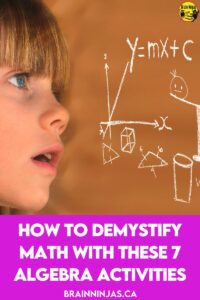
The biggest problem with algebra is the mental block that people have around it. There is a huge fear that algebra is this big scary thing that adults still don’t understand.
Truthfully, you don’t want to pass along your fears of math to the students you teach (and that applies to parents, too). Anyone can do math – it is a skill that uses a muscle, so it can be taught and learned. Unfortunately, most of us were taught math through algorithms and repetition, which means we have very little understanding of how numbers work. This is also the reason many parents are afraid of “new” math. Math lessons today start with concepts instead of procedures. The focus is on understanding how and why before memorizing steps.
People equate algebra with confusing equations and letters. The simplest possible way to describe algebra is solving for an unknown value. We do this all the time when we add or multiply. Any time we use an equal sign to solve for a number, we’re technically doing algebra activities.
Before we start…
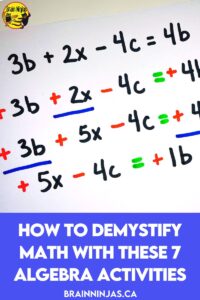
Students need a few words to help them understand what is happening in an equation. They do not need to know what these are called, but we always try to use the correct terminology with students when possible. If you need to brush up, here are some definitions.
expression: a statement having at least two numbers, or variables (or both), and an operation
equation: a statement that shows that two mathematical expressions are equal (contains an equal sign). An example is 2 + 4 = 6 or 2x + 4 = 12.
term: the pieces of an expression. For example: 2x + 4 = 12. The terms are 2x, 4, and 12. Terms are usually (but not always) separated by operation symbols or the equal sign.
variable: a letter (or shape) that represents an unknown value.
coefficient: a number that is written along with a variable or it is multiplied by the variable. For example: in 2x + 4 = 12, the coefficient is 2.
constant: a fixed number that generally doesn’t change. For example: in 2x + 4, the 4 is a constant.
Balance It
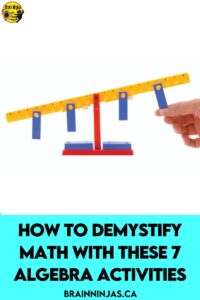
Use a scale to balance numbers. The physical act of hanging numbers on a balance can help students understand the concept of balancing an equation. You will be able to refer to the visual of balancing throughout your algebra unit.
If you don’t have access to balance in your classroom, you can find some online.
The algebra understanding: Explain that in algebra, both sides of the balance need to be equal. That is why an equal sign is used. Undo the years of students assuming that an equal sign means “answer.”
Clumping
This is a sorting activity that helps students learn how to sort terms within expressions and equations.
Grab a pile of objects that have different attributes that can be sorted. In our example, we have used pattern blocks. Drop a small pile of objects. Have students sort the items by the attribute and give each pile a letter (this is to represent a variable). Count the number in each pile and put it next to the letter. This will represent the coefficient. Now students can write an expression.
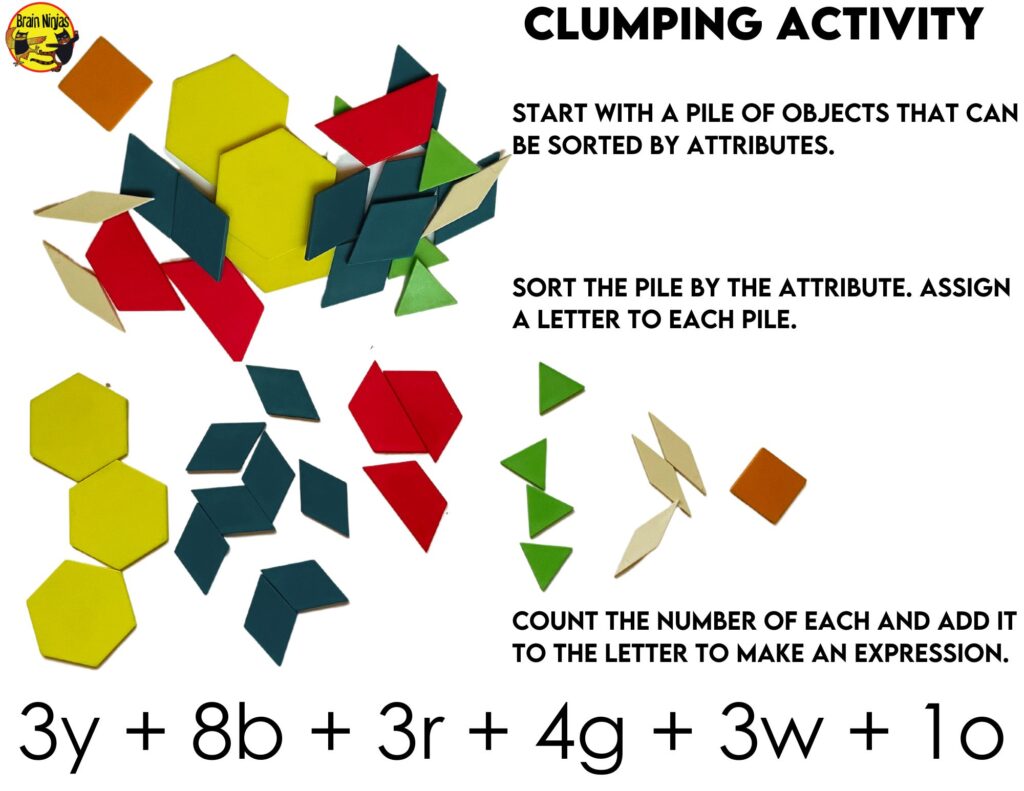
The algebra understanding: Before trying to solve for unknown values, group the common terms together.
Equalizer
Understanding that an equal sign is a balance, doing the same thing to both sides. Place a variety of objects that can be sorted by attributes on both sides of the equal sign. Remove the exact same objects from both sides until there are only like objects on each side. Write an equation by counting the number of objects and giving each type its own letter (variable).
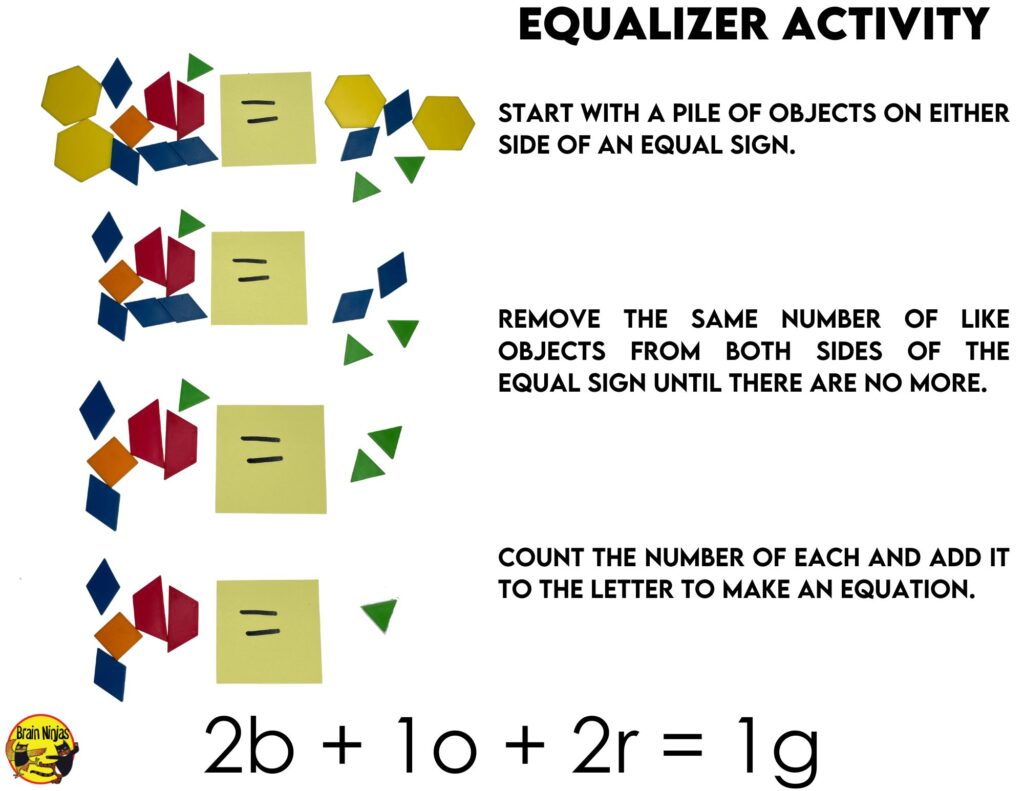
The algebra understanding: When balancing equations, you must do the same thing to both sides of the equal sign.
Flip It
One of the most common errors students make when solving equations is flipping numbers to the other side of the equation correctly. It is important that students first understand that flipping the number is a shortcut. This can be tricky because students don’t always see that adding 3 to both sides of an equation will have a different result for a positive or a negative number. Adding three to -3 makes it zero, which means the term will be taken away.
When you’re teaching students to balance equations, stick to one method until they have mastered it. Then, teach another. Once students know more than one method, have them stick to the same method to reduce confusion.
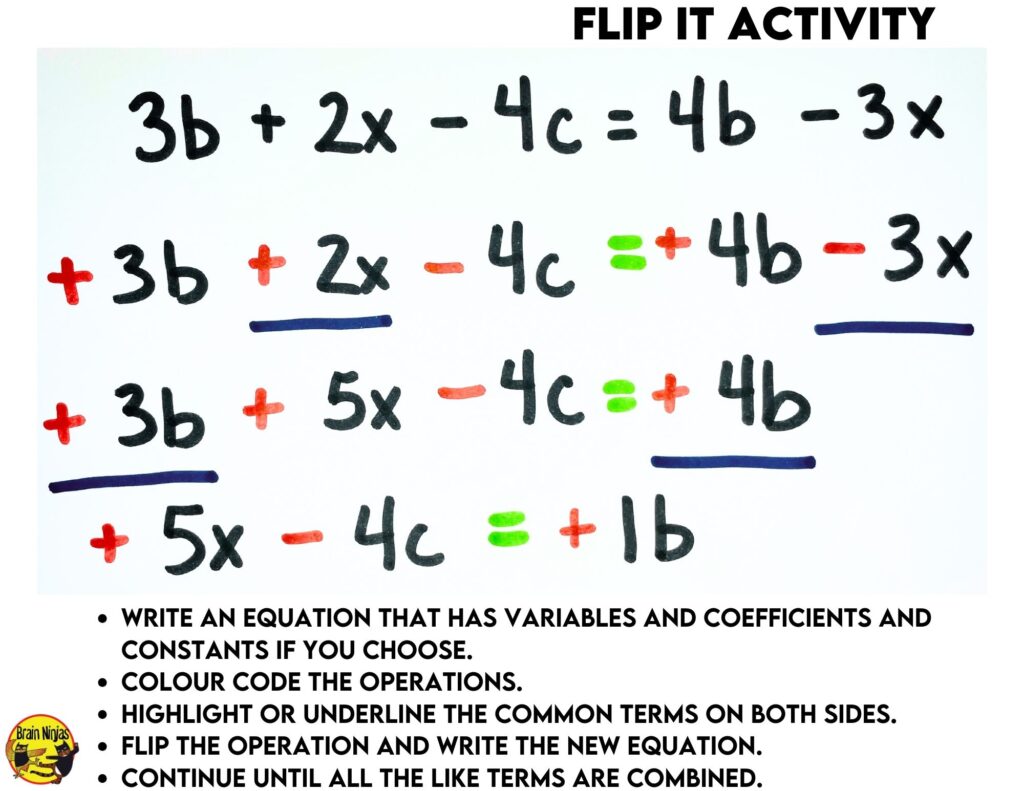
The algebra understanding: When balancing equations, use the opposite operation when placing a term on the other side of the equal sign.
That’s Wrong?
Give students an incorrect equation and have them figure out the error. Error analysis is a great way to have students check for understanding. Read more about it in our post, How to Teach Students to Analyze Errors in Math.
Get a free error analysis activity in our Resource Library to members of our email list. If you’re not on the list, we can send it directly to your inbox.
Algebra Tiles
I had never heard of algebra tiles until I was an adult in university. Once I started using them, algebra clicked immediately. Why aren’t these more accessible to everyone?
The idea behind algebra tiles is that the small yellow squares represent positive numbers (constants). The green bars represent x (the variable). The large blue squares represent x² (the variable). If any of these are red, they represent the negative.
So, if you have 2 yellow squares and one green bar, written as an equation it would be 2 + x.
My favourite online place to use them is this site. We have a template included in our interactive math units so that your students can make their own sets.
Teach It With These Algebra Activities
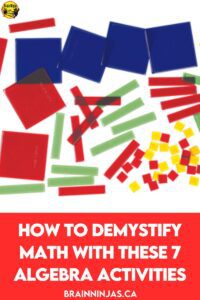
If you are looking for ways to teach introductory algebra, we use our Interactive Math Units. These units include a complete lesson plan for the teacher. Students will create a page for each concept. This page includes all the information students will need as they practice and work toward mastery. We’ve also included some practice pages and activities to use. Lastly, we’ve included assessment pages so you can check on the learning of your students.
Our Grade 3 Patterns and Algebra Interactive Math Unit is available on TpT ($USD) or our BN Shop ($CAN).
Grade 4 Patterns and Algebra Interactive Math Unit is available on TpT ($USD) or our BN Shop ($CAN).
Our Grade 4/5 Patterns and Algebra Interactive Math Unit is available on TpT ($USD) or our BN Shop ($CAN). This is designed for combined grade levels.
Grade 5 Patterns and Algebra Interactive Math Unit is available on TpT ($USD) or our BN Shop ($CAN).
Our Grade 5/6 Patterns and Algebra Interactive Math Unit is available on TpT ($USD) or our BN Shop ($CAN). This is designed for combined grade levels.
Grade 6 Patterns and Algebra Interactive Math Unit is available on TpT ($USD) or our BN Shop ($CAN).
Need more algebra activities?
If your students need to practice specific skills, we have worksheets available. If you’re looking to take worksheets to the next level by turning them into engaging games, check out our post Math Worksheet Games Your Students Will Love.
Patterns
These worksheets include concrete and pictorial patterns, numbers, sequences and patterns in tables and on planes.
Pattern Concepts and Vocabulary Worksheets are available on TpT ($USD) or our BN Shop ($CAN).
Our Equality and Inequality Worksheets are available on TpT ($USD) or our BN Shop ($CAN).
Pictorial, Concrete and Numerical Patterns Worksheets are available on TpT ($USD) or our BN Shop ($CAN).
Describing and Extending Patterns Worksheets are available on TpT ($USD) or our BN Shop ($CAN).
The Sorting Numbers in Charts by Attribute Worksheets are available on TpT ($USD) or our BN Shop ($CAN).
Patterns in Tables and Charts Worksheets are available on TpT ($USD) or our BN Shop ($CAN).
Our Number Patterns and Sequences Worksheets are available on TpT ($USD) or our BN Shop ($CAN).
Finding Patterns on Coordinate Planes Worksheets are available on TpT ($USD) or our BN Shop ($CAN).
The Pattern Concepts on Coordinate Planes Worksheets are available on TpT ($USD) or our BN Shop ($CAN).
Algebra
These worksheets focus on solving equations, working variables and using the order of operations.
Solving for an Unknown | Addition and Subtraction Worksheets are available on TpT ($USD) or our BN Shop ($CAN).
Our Solving for an Unknown | Multiplication and Division Within 25 Worksheets are available on TpT ($USD) or our BN Shop ($CAN).
Solving for an Unknown | Multiplication and Division Within 100 Worksheets are available on TpT ($USD) or our BN Shop ($CAN).
Writing Algebra Expressions and Equations Worksheets are available on TpT ($USD) or our BN Shop ($CAN).
Solving Algebra Expressions and Equations | Addition and Subtraction Worksheets are available on TpT ($USD) or our BN Shop ($CAN).
Our Solving Algebra Expressions and Equations | Multiplication and Division Worksheets are available on TpT ($USD) or our BN Shop ($CAN).
Solving Algebra Expressions and Equations | Order of Operations Worksheets are available on TpT ($USD) or our BN Shop ($CAN).
The Solving Expressions for All Operations Worksheets are available on TpT ($USD) or our BN Shop ($CAN).
Solving Expressions With Order of Operations and Brackets Worksheets are available on TpT ($USD) or our BN Shop ($CAN).
Our Solving Expressions With Order of Operations, Brackets and Exponents Worksheets are available on TpT ($USD) or our BN Shop ($CAN).
Province-Specific Bundles and Sets for Patterns and Algebra
We have designed bundles that include specific worksheets aligned for different provinces.
Alberta Grade 3 Patterns & Algebra is available on TpT ($USD) or our BN Shop ($CAN).
Our Alberta Grade 4 Patterns & Algebra is available on TpT ($USD) or our BN Shop ($CAN).
Alberta Grade 5 Patterns & Algebra is available on TpT ($USD) or our BN Shop ($CAN).
Alberta Grade 6 Patterns & Algebra is available on TpT ($USD) or our BN Shop ($CAN).
British Columbia Grade 3 Patterns & Algebra is available on TpT ($USD) or our BN Shop ($CAN).
Our British Columbia Grade 4 Patterns & Algebra is available on TpT ($USD) or our BN Shop ($CAN).
British Columbia Grade 5 Patterns & Algebra is available on TpT ($USD) or our BN Shop ($CAN).
British Columbia Grade 6 Patterns & Algebra is available on TpT ($USD) or our BN Shop ($CAN).
Saskatchewan Grade 3 Patterns & Algebra is available on TpT ($USD) or our BN Shop ($CAN).
Our Saskatchewan Grade 4 Patterns & Algebra is available on TpT ($USD) or our BN Shop ($CAN).
Saskatchewan Grade 5 Patterns & Algebra is available on TpT ($USD) or our BN Shop ($CAN).
The Saskatchewan Grade 6 Patterns & Algebra is available on TpT ($USD) or our BN Shop ($CAN).
Looking for other math topics?
7 Ways to Upgrade Your Fraction Strategies
How to Make Teaching Patterns Painless
Amazing Measurement Activities to Stretch Math
How to Teach Students to Tell Time
How to Teach Successful Long Division Strategies
Ways to Bring Graphing Activities into Your Classroom Daily
How to Help Your Students Master Decimal Operations
How to Teach Students to Analyze Errors in Math
Mastering the Angles: Innovative Approaches to Teaching Geometry Concepts
How to Use Interactive Notebooks to Teach Number Sense
How to Change Math With Interactive Notebooks
Conquer Math With These Proven Multiplication Strategies
Ways to Teach Classifying Triangles
How to Teach Rounding Numbers
What other tricks do you have for introducing algebra to your students? We’re always looking for more algebra activities. Let us know in the comment below.

